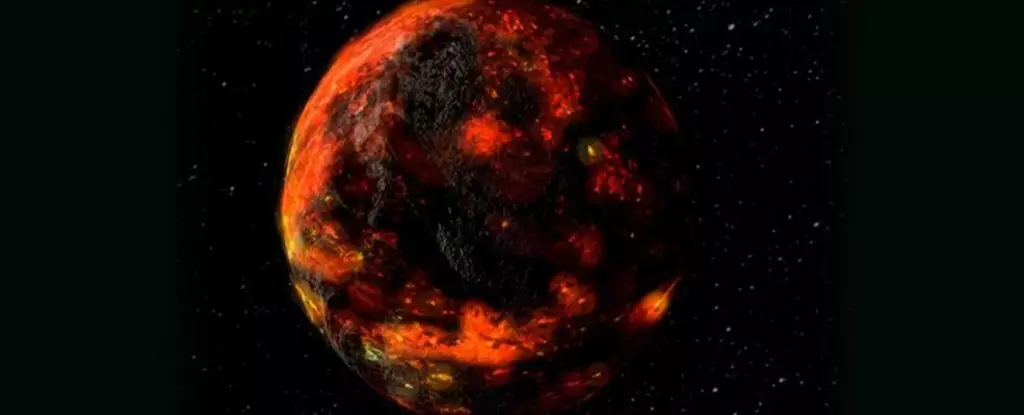The Moon has long captivated humanity, not just for its beauty but for the secrets it holds about our early solar system and the formation of Earth. Despite significant advances in lunar science, many questions remain regarding the Moon’s formative years. Recent research sheds light on the Moon’s geological history, particularly its solidification process following the primordial magma ocean phase. Researchers, led by Nicolas Dauphas at the University of Chicago, have analyzed lunar rocks retrieved during the Apollo missions and have provided new insights into the development of the Moon over the past 4.43 billion years.
The recent study reveals that the Moon solidified approximately 4.43 billion years ago, a timeline strikingly close to the point when Earth transitioned into a habitable zone. By meticulously examining the elemental composition of lunar samples, Dauphas and his team contribute to our understanding of the conditions that prevailed on the Moon after it formed from debris resulting from a colossal collision between early solar system bodies, specifically a Mars-sized entity known as Theia.
In the aftermath of this celestial impact, the Moon existed as a molten sphere, which began through a cooling process that led to stratification within its structure. This cooling allowed for the separation of different materials, resulting in a solid crust and a fascinating layer of residual liquid termed KREEP, which consists of potassium, rare earth elements, and phosphorus. The formation of KREEP approximately 140 million years after the solar system’s birth offers important clues regarding the evolutionary processes that influenced the Moon’s surface.
Understanding KREEP and Lunar Evolution
KREEP plays a pivotal role in the Moon’s geological narrative, serving as a marker for the processes that followed its formative years. This distinctive reservoir is crucial for comprehending the timeline of lunar solidification and the eventual development of geological features such as mare basalts. Preliminary analyses suggest that KREEP could offer a uniform distribution across the lunar surface, which scientists aim to confirm, specifically in areas like the South Pole-Aitken basin where future Artemis missions are set to occur.
One of the fascinating aspects of the study centers on lutetium, a weakly radioactive rare earth element. The decay of lutetium to hafnium acts as a temporal marker for dating geological formations. By comparing the ratios of these elements in lunar rocks to samples from meteorites and other celestial bodies originating around the same period, researchers can refine our understanding of the timeline surrounding KREEP’s formation. The analysis indicated that the ratios aligned with a formation timeframe of approximately 4.43 billion years ago, corroborating the earlier estimates of the Moon’s solidification.
What the research further illustrates is that the Moon’s cooling did not occur in isolation; rather, it unfolded during a period significantly influenced by the bombardment of leftover planetary debris from the solar system’s birth. This chaotic environment meant that as the Moon was beginning to cool and solidify, it remained subject to impacts from celestial objects, which were integral in reshaping its surface. These impacts later encouraged volcanic activity, leading to the generation of mare basalts, which have since become characteristic of the lunar landscape.
The study’s findings indicate that the formation of the lunar surface features—defined by the cooling processes and subsequent impacts—are key to understanding both the Moon’s geological history and Earth’s evolution. This interconnectedness implies that the Moon’s history could reveal much about the conditions faced by the early Earth, particularly during a critical phase of planetary stabilization conducive to the emergence of life.
Future Explorations and Implications for Moon Science
As missions like Artemis and Chang’e aim to collect further samples from the Moon, particularly from previously unstudied regions, the potential for new discoveries about its formation and evolution will increase. The analysis of lunar rocks will not only illuminate the Moon’s past but also offer broader insights into planetary formation processes and the evolutionary trajectories sustained by Earth and other bodies within the solar system.
The ongoing investigation into the Moon’s history, marked by innovative methodologies and analysis, continues to augment our understanding of our nearest celestial neighbor. By linking lunar solidification timelines with Earth’s geological narrative, scientists will uncover deeper truths about our planet’s past and the conditions that ultimately led to the nurturing environment for life. The journey to unveil the Moon’s history is far from complete, but these findings pave the way for future exploration and discovery.


Leave a Reply